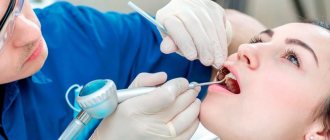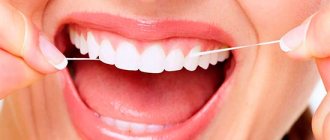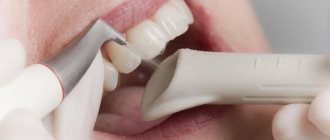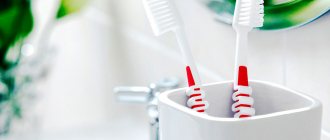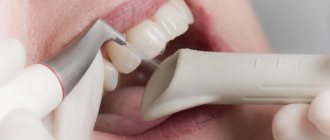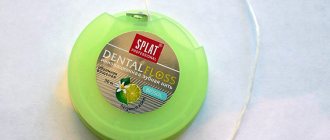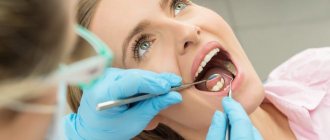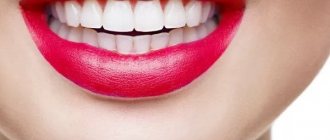Professional teeth cleaning includes a whole range of measures aimed at completely cleansing the surface of the teeth and oral cavity from all types of dental deposits. Due to the fact that many clients of the Apex dental clinic often ask the question of how teeth are cleaned, today we decided to talk in more detail about this, paying attention to the methods of professional cleaning.
Let's talk about the two most popular teeth cleaning options today: ultrasonic teeth cleaning using an ultrasonic device and the Air Flow method, which involves the use of a device that sprays a mixture of water, air and crystalline soda onto the teeth under high pressure. Well, first, let’s look at the process of professional teeth cleaning in general.
How does teeth cleaning work at a professional level?
First of all, to carry out professional teeth cleaning, you need to make an appointment with a dentist-therapist at a dental clinic, since it is this doctor who carries out the procedure.
It is mandatory to preliminarily assess the condition of the teeth and oral cavity, and identify indications and contraindications for the manipulation. After consultation with a specialist and an objective examination, the dentist cleans the enamel from plaque and stones. At this stage, various tools and equipment can be used, including ultrasonic teeth cleaning, Air Flow system, etc.
After removing all types of dental plaque, the surface of the teeth is polished to remove some stains, as well as to smooth their surface as much as possible to prevent the formation of plaque in the future. The final stage of professional cleaning is the application of fluoride varnish to strengthen the teeth.
Contraindications
- Cardiac arrhythmia.
- Bronchial asthma.
- Enamel hyperesthesia.
- The presence of serious diseases - hepatitis, HIV/AIDS, tuberculosis. In these cases, the possibility of carrying out Air Flow cleaning is determined by the doctor on an individual basis.
It would hardly be correct to consider Air Flow a full-fledged method of teeth whitening. First of all, we are talking about removing plaque and stones. However, a thoroughly cleaned enamel surface will in any case become lighter, and your smile will be brighter and more attractive.
Indications for professional teeth cleaning
There are many indications for professional teeth cleaning, ranging from the banal presence of dental deposits, including tartar, and ending with preparation for dental implantation or other serious dental interventions.
The extremely beneficial effects of teeth cleaning in a dental office determine the popularity and demand for such a service. Remember that regular visits to a dentist for medical examinations and professional cleaning are the key to the health and longevity of your smile!
Stages of the procedure
Air Flow teeth cleaning is carried out in several main stages.
Specialist:
- Covers the patient's lips with Vaseline. This will prevent them from drying out.
- Places a saliva ejector in the patient's mouth. It gets rid of saliva, which is actively released during the procedure.
- Puts a special hat and glasses on the patient. They protect the face and hair from small particles and abrasive powder used when brushing teeth.
- Carefully treats each tooth. It is important that the jet does not hit soft tissues or dentin. With caries and erosion, the patient may experience discomfort.
- Covers treated enamel with a fluorine-containing compound. It consolidates the resulting effect.
Remember: the force of the jet pressure is controlled by the dentist independently.
This is how it controls the force applied to soft and hard deposits. Thanks to this, the procedure becomes more effective. In this case, plaque and food debris are carefully removed, the patient does not feel any pain.
It is also a good prevention of caries.
Features of ultrasonic cleaning and teeth cleaning with the Air Flow device
If we talk about ultrasonic teeth cleaning, this procedure includes several directions of action. First of all, the method allows you to effectively clean your teeth of plaque, including that formed as a result of smoking and eating food coloring. Ultrasound effectively fights subgingival and supragingival dental plaque, including hard tartar.
Using ultrasonic teeth cleaning, it becomes possible to rinse periodontal pockets, the lack of timely treatment of which often leads to inflammatory diseases of the gums and periodontium. In addition, ultrasonic teeth cleaning, however, as when using the Air Flow device, involves polishing the teeth using professional pastes.
As a result of ultrasonic teeth cleaning, a slight whitening effect is observed (on average by 1–2 shades). The advantages of the method are its versatility and high quality, painlessness and safety, as well as the bactericidal properties of ultrasound.
As for brushing teeth with Air Flow, this procedure uses a high-pressure jet of a mixture of water, compressed air and sodium bicarbonate (soda). The result is the cleansing of dental surfaces from all types of dental plaque and the elimination of surface pigmentation. Air Flow teeth cleaning is also effective in interdental spaces.
Comparison of methods
To sum it up, Air Flow is the ideal dental care option for anyone with crowns and implants. Also, this method is best suited for smokers, tea and coffee drinkers.
Ultrasonic cleaning is the only way to remove stone under the gum and in hard-to-reach places. This method can be used by anyone who suffers from inflammation and bleeding gums. Ultrasonic treatment sterilizes the tooth surface and has anti-inflammatory and antibacterial effects.
Recommendations after professional teeth cleaning
To ensure that the results of professional teeth cleaning with ultrasound or the Air-Flow method are as long-lasting as possible, experts recommend adhering to the following rules whenever possible:
- After the procedure, replace your toothbrush, and make it a rule to change it strictly every 3 months.
- It is also recommended, within two days after professional teeth cleaning, to eliminate, if possible, the influence of external factors that contribute to the deterioration of the condition and color of teeth. These include smoking, drinking coffee and tea, other coloring products (berries, ketchup and tomatoes, chocolate and red wine), etc.
- Experts also draw attention to the importance of thoroughly brushing your teeth according to all the rules (twice a day, if necessary, using dental floss and mouthwash, etc.)
- It is recommended to use toothbrushes with soft bristles, due to the fact that even products with a medium degree of hardness often cause “micro-scratches” on the enamel, where plaque subsequently accumulates and easy penetration of pigments occurs, changing the color of the teeth.
- To maintain the health and beauty of your teeth, it is recommended to have your teeth professionally cleaned twice a year.
Stages of the procedure
In general, ultrasonic cleaning is carried out in several main stages.
- Examination of the patient’s oral cavity, checking its problem areas, the degree of plaque.
- Numbing problem areas, but numbing them if necessary.
- Skyler. In this case, the device has two operating modes. The procedure is carried out with a thin stream of water or dry. The power of impact is also determined by a specialist.
- Treatment of teeth, grinding them with a drill and a special attachment. They can also be sanded with hand tools.
- Covering each tooth with fluoride-containing gel and varnish. It reduces the sensitivity of the enamel for 2-3 days.
Air flow: reviews
Air flow teeth cleaning – the reviews are extremely positive, and patients, speaking about the shortcomings, only remember pain in the neck area of the teeth during the procedure (24stoma.ru). The temperature of the water-air spray is slightly lower than body temperature, and therefore people with increased sensitivity of the enamel may well experience moderate discomfort, which, however, is quite tolerable.
Advantages of Air flow –
- High-quality cleaning of tooth enamel, root surfaces in periodontal pockets - from bacterial and pigmented plaque, even in the spaces between teeth.
- An amazing feeling of freshness in the mouth after the procedure, as well as the smoothness of the tooth enamel.
- The procedure causes less discomfort than ultrasonic cleaning, which may be important for people who are afraid of dental procedures.
- Air-flow and Air-flow Perio allow you to remove the bacterial film with endotoxins from the surface of the roots in periodontal pockets. This is very important in patients with periodontitis, and allows, in combination with basic periodontal treatment, to achieve stable remission of the disease.
Contraindications and disadvantages of Air flow –
- The method allows you to remove only pigment plaque and very small hard dental deposits. To remove massive deposits before the AirFlow procedure, the dentist will be forced to perform ultrasonic cleaning on you.
- The method cannot be used during an active inflammatory process in the gums, but can be carried out after the inflammation subsides.
- You cannot carry out AirFlow if you have bronchial asthma or asthmatic bronchitis, because... there is a high probability of developing bronchospasm. We hope that our article: Cleaning and whitening AirFlow cost reviews was useful to you!
Sources:
1. Add. professional
, 2. Based on personal experience as a periodontist, 3. National Library of Medicine (USA), 4. American Academy of Periodontology (USA), 5. https://www.ems-dental.com/.
Choosing the appropriate professional hygiene method
Which is better: ultrasonic cleaning or Air Flow? Having compared the advantages and disadvantages of both methods, it is impossible not to mention the frequency of their potential use. Ultrasound can be used once every six months, but the effect of such exposure is more long-term and noticeable. Air Flow is recommended for use every 3 months. The duration of work in both cases is about half an hour. However, the difference in the cost of the procedures is small.
When making a choice at the dentist's office, it is important to understand what goals you are pursuing. If the main task is to remove pigment, traces of dyes and light deposits, it is enough to use Air Flow. In a situation where a more thorough approach is needed - removal of tartar, prevention of caries and dental diseases, it is better to give preference to ultrasound exposure.
Regular oral and dental care will reduce the cost of treating diseases, so do not neglect professional hygiene procedures.
Air flow whitening –
Air flow teeth whitening – occurs by removing from the tooth surface absolutely all surface contaminants that can change the color of the tooth (bacterial and pigment plaque). However, you must understand that Air flow cannot change the natural color of the hard tissues of teeth - the latter can only be achieved through a chemical teeth whitening procedure.
Thus, Air flow whitening occurs only by removing external contaminants from the surface of the teeth - almost exactly the same as abrasive-type whitening toothpastes do. It is only natural that such pastes will be much less effective than professional cleaning or chemical bleaching.
Questions for doctors
Patient: “Good afternoon, I’m very worried because I made an appointment for cleaning immediately after caries treatment. Will this cause new dental problems? Will the filling be ok? If I have an appointment for braces, can I have the cleaning done the day before? Or when is the best time to do it? Thank you in advance".
Doctor: “Good day!
Dental cleanings should usually be performed before dental treatment to remove plaque. This is explained by the need to remove harmful bacteria. In exceptional cases, teeth affected by caries are first treated, which is what happened in your situation. Cleaning the filling will not harm the filling in any way.
As for braces, cleaning should be done 3-5 days before fixation. True, there are exceptions in these situations. The doctor prescribes cleaning based on special indications.”
Patient: “Hello, tell me, is there a chance of contracting any infection during dental cleaning? For example, I constantly bleed during this procedure.”
Doctor: “Hello!
There are many different microorganisms living in the human mouth, and not all of them are safe. Pathogenic microorganisms accumulate in the form of plaque or dental plaque. Such deposits are found on the top of the tooth or under the gum. Then bleeding gums can develop, and when the dentist is careful, the bleeding stops very quickly, even before the manipulations stop. To prevent bleeding from happening, you need to get rid of deposits on your teeth - maintain hygiene and constantly carry out dental cleanings.”
Patient: “Hello, I’ve been tormented by tartar for a long time, so I decided to have a dental cleaning. But I don’t want to spend money all the time. So I’m wondering: is one-time cleaning effective? Do teeth deteriorate after just one brushing?”
Doctor: “Good day!
Such procedures need to be done at least twice a year. The situation you described shows that you are predisposed to the formation of tartar, which can lead to tooth loss at a young age. In addition, harmful microorganisms that live in dental plaque can infect the entire body. Therefore, you should still consider regular professional cleaning.”
Patient: “Two months ago a filling fell out. I want to have a dental cleaning. So what is better - return the filling or have it cleaned? And isn’t extension a contraindication?”
Doctor: “Good afternoon!
First, you need to see a dentist. He will tell you what is best to do first. You can combine these two procedures. Dental growth is not a contraindication for professional cleaning.”
Patient: “Hello, I need your help. After I had ultrasound and Air Flow cleaning done, I feel severe discomfort due to the roughness of my teeth. Is this normal? Or did the doctor make a mistake during the procedure? And what does this threaten me with?
Doctor: “Hello!
Rough tooth enamel can be explained by the characteristics of the surface, or you still have dental plaque. It's difficult to judge because I don't see the whole picture. It’s better to go to your dentist, who will draw conclusions based on the examination. Don’t delay going to the doctor, as rough enamel can injure your tongue.”
Patient: “Hello, about a week ago I had ultrasonic cleaning and was advised to rinse with Miramistin, and also recommended Metrogyl Denta and Imudon. I still can’t eat anything except cereals and soft yoghurts. Every day I notice deterioration. My gums are constantly inflamed, my head and throat hurt. What should I do?
Doctor: “Good afternoon!
- Continue rinsing your mouth and throat with Miramistin; I also recommend adding herbal infusions (chamomile, for example).
- For damaged areas, use Solcoseryl. This is a special gel that relieves pain and inflammation and promotes healing. You can use sea buckthorn or rosehip oils, or take Imudon. Vitamin A also helps. Apply them using cotton swabs.
- Change the brush to a softer one.
- Be sure to visit a therapist if your head and throat continue to hurt.”
What's not allowed?
After thoroughly cleaning your teeth, you should reconsider your diet and bad habits. The following list should be banned.
- Eating excessively hard foods.
- Abuse of products with a high content of coloring substances (both natural and artificial).
- Eating foods high in acids.
- Tea, coffee, chocolate, red wine.
- Cigarettes.
If you don’t want to give up this list, then you need to be prepared for the fact that very soon a new pigmented plaque will form on the surface of the tooth enamel, and it will become more sensitive.
The first time after the procedure, there may be unpleasant painful symptoms, increased sensitivity of the teeth and slight bleeding of the gums. If you follow all the dentist’s recommendations, they disappear after 1 – 2 days.
Air Flow: price 2022
The price range for this service is very wide. Much will depend on the equipment: the cost of a service using an original EMS device will be an order of magnitude higher than working with an NSK AirFlow handpiece. Accordingly, this will greatly affect the final cost of the service.
In addition, the price depends on whether you need to do only Air flow, or whether you need a comprehensive cleaning, which will also include ultrasonic cleaning + fluoridation of teeth after the procedure. Such a comprehensive cleaning in the regions will cost starting from 2500 rubles, in Moscow - from 3500-4000 rubles (in economy class clinics).
If you only need to do Air Flow, the price in different Moscow clinics ranges from 2,500 thousand to 5,000 rubles.
How to clean with braces?
The presence of braces almost always interferes with comprehensive teeth cleaning, so plaque and various harmful deposits appear around them. Air Flow will help you get rid of these problems. The composition sprayed onto the teeth will effectively rid their surface of dirt.
Important! Bacterial or pigment plaque is a signal that caries may soon develop. In advanced cases of caries, there may be complications such as periodontitis or pulpitis. Then a person risks losing a bad tooth.
Air Flow cleaning helps protect your teeth from such dangerous diseases.
